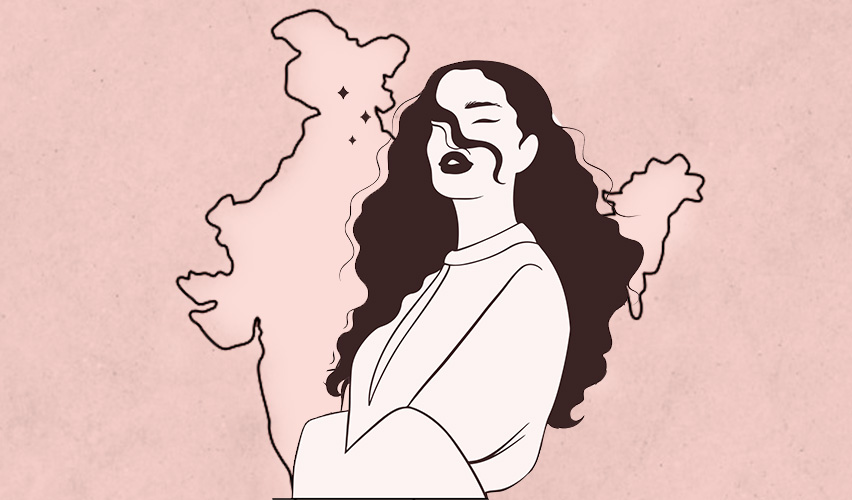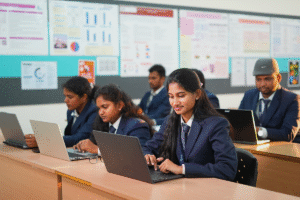International Women’s Day – 2021

Prof. Usha Manjunath Ph.D.
Director, IIHMR Bangalore
Another year has rolled by and we are here celebrating International Women’s Day – 2021. This year has been more important than any other, amidst the COVID – 19 Pandemic, India’s attempts at Universal Health Coverage – Women’s Health deserves a closer look.
Universal Health Coverage: UHC is built on the notion of EQUITY (UN 2015) – one that everyone should be covered and the other that the health services should be allocated according to people’s needs. For instance, people with higher needs like young pregnant women, infants/children and chronically ill should be able to receive more services than the others. Most critical to low-middle income countries like India is the financing side of the healthcare for enhancing demands and access. Currently, out-of-pocket expenditure (OOPE) stands at 65% for healthcare services in the nation. OOP Expenditure has shown a slight decline over the last decade. The Economic Survey 2021 with an apt theme of ‘Saving lives and livelihoods’ in the context of pandemic and has tried to analyze various aspects of economy and living. UHC obviously must include aspects of life course women’s health: MCH (Maternal and Child Health), adolescents, non-communicable diseases, gender-based violence, elderly, and mental health. Access and actual utilization of optimal levels of care by women is not always easy to achieve.
AB PM – JAY: The ambitious Ayushman Bharat – Pradhan Mantri Jan Arogya Yojana started in 2018 providing financial protection to the most vulnerable groups for availing health services and initiating ‘Health and Wellness Centers’ in nearly 1.5 lakh sub-centers to address the increasing prevalence of non-communicable diseases (often referred to as ‘lifestyle diseases’) have been lauded as one of the largest health programmes in the world. This along with National Health Mission programme (after a decade of NRHM and its success in primary healthcare mainly Maternal and Child Health) is considered as positive developments in the country. The schemes are popularly known as Ayushman Bharat implemented in most of the states, and in Karnataka it is referred to as ‘Ayushman Bharat – Arogya Karnataka’ (AB – ArK). Even though National Health Policy 2017 envisaged to increase government spending of the health sector from the current 1% to 2.5% of GDP in order to reduce OOP expenditure, the reality and the COVID – 19 pandemic somewhat derailed the plans. As we are trying to grapple with the regulation of the health sector and mitigating information asymmetry for better insurance penetration, ‘TELEMEDICINE emerged as a boon with better acceptability, utilization and reach/coverage’ during the pandemic.
Given the above background let us examine how ‘WOMEN’S HEALTH’ is panning out, its status and some insights on the emerging health landscapes. The below discussion covers ‘Maternal Health’, ‘Health risk factors’, ‘Non-Communicable Diseases’. The data this article is drawn from National Family Health Survey 4 and NFHS 5 (Karnataka State for which the fact sheets are available). The other sources used in this article includes Report by George Institute, and Longitudinal Ageing Study in India (LASI) – Wave 1.
The last section ‘Access to Treatment and Health Service Utilization’ examines how AB PM-JAY utilization has impacted women’s health and treatment procedures based on the Working Paper – 005 published on the National Health Authority Portal and other sources.
Maternal Health: One of the most important indicators of a nation’s health is that of how pregnant women, young mothers and infants are cared for. Maternal Mortality Rate (MMR – number of maternal deaths per 1,00,000 live births) is a very critical indicator of women’s sexual and reproductive health (SRH). Sustainable Development Goals (SDG) target 3.1 set by United Nations for MMR is less than 70. Office of the Registrar General’s Sample Registration System (SRS) has reported of a decline in MMR from 130 in 2014 – 2016 to 122 in 2015-2017 to 113 in 2016-2018. India’s commitment to maternal and reproductive health through various programmes and mission mode approach through NRHM from 2005 has shown positive impact. Community level reach through ASHA played a key role in achieving it. Antenatal checkup, birthing and postnatal care are essential features of maternal health. Figure 1 clearly indicates that ANC coverage and institutional deliveries are showing good progress, particularly in the case of Karnataka. But on the downside, anemia among pregnant women continues to be high, close to 50%. Consumption of IFA tablets are not high either. Further, studies have shown that the women are discharged from the labour wards too soon after delivery; practices during delivery include routine episiotomies, application of excessive Fundal pressure, unnecessary oxytocin injections and other practices meant to speed up delivery including C- Section have become the norm; and poorly trained personnel are unable to recognize or manage obstetric emergencies . For example, choosing and conducting of C-section deliveries where normal deliveries are indicated, is a cause of concern, on the one hand we can consider that the safety of the mother and child is ensured but on the other hand it pushes up costs of care (including out-of-pocket expenses) and surgery related complications.
Poverty, social constructs, and biases of a patriarchal society has all through history have had negative effects on health of young girls and women. ‘Early marriage and early pregnancy’ continue to complicate the situation. Unicef report on Ending Child Marriage indicated that child marriage rate in 2000 has come down to 27% by 2015 in India. However, the pandemic would adversely impact the health of the adolescent girls: without formal school and internet access, girls would be sent to supplement family income through domestic work/child labor and end up being married early.

Many programmes by the Government like Pradhan Mantri Matru Vandana Yojana, and hot meals for pregnant and lactating women (by Department of Women and Child Development/ICDS) have helped. But much of the deep-rooted problems of health, nutrition, access to safe drinking water, sanitation etc cannot be wished away easily.


Cancers of oral cavity and lungs in males and cervix and breast in females account for over 50 percent of all cancer deaths in India. One woman dies of cervical cancer every eight minutes in India. Cervical and breast cancer are most common ones in women. A report stated that one in 28 women in India is likely to develop breast cancer during her lifetime (1 in 22 for urban and 1 in 60 for rural women). Cervical cancer is the second most common cancer among women aged 15 – 44 years in India. The incidence of breast cancer has surpassed that of cervical cancer in India and it is the leading cause of death. When we examine the screening and early detection of cancer, Indian women fair very poorly. Women (15-49 years) who have had screening/examination of Cervix, Breast and Oral Cavity are quite low 22.3%, 9.8% and 12.4% respectively. Poor menstrual hygiene quite prevalent among women in India is a major risk factor for reproductive tract, urinary tract, and human papilloma virus infections too.
Another critical area is that of mental health and mental illness. It is reported that depression, anxiety, and unspecified psychological distress are 2 to 3 times more common among women than among men. Women (Table 1) are physically quite active in 45 years and above but could benefit more from relaxation or yoga practice. Early identification, diagnosis, treatment, care, and support on mental health front have a long way to go for all Indians, more so for women.
Access to Treatment and Health Service Utilization: Addressing the financing side of healthcare is identified as the most important to enhance demands and access. WHO (2016) by disaggregating health coverage data has shown that women stand disadvantaged due to economic inequalities; they have higher healthcare needs than men throughout their life-cycle. Health insurance coverage or scheme is quite low in India. NFHS 4 indicates that 28.7% of households with any usual member covered, one would expect better coverage for people in Karnataka. However, NFHS 5 indicates coverage of 28.1% only. The overall coverage of Janani Suraksha Yojana in India is about 36.4% and depicts high regional, district and socioeconomic group variations. Average OOP expenditure per delivery in public health facility stood at Rs. 3197 for India and results for Karnataka show Rs. 4824 and Rs. 4954 (NFHS 4 and 5 respectively). Jan Aushadhi yojana should reduce the OOP expenditure as most of it comes from purchase of medicines.
Under the Rashtriya Suraksha Bima Yojana (RSBY), round one ‘male member enrolment’ was higher than for females (60:40) and round two showed 44% women enrolment. Common sense tells us that the women’s healthcare needs would be higher considering pregnancy and childbirth, longer life expectancy, domestic violence etc., lesser coverage obviously means poor outcomes! AB PM-JAY has addressed the issues by introducing the concept of entitlement and eliminating enrollment-based differentials. Launched in 2018, the Government mega scheme proposed to cover 10.74 crore families with the benefit coverage of Rs. 5 lakhs for secondary and tertiary care. The services include approximately 1,393 treatment packages for 25 specialties in Health Benefit Packages 1.0 (HBP 2.0 has 1, 578 procedures covered). Under 1,393 packages, 116 are women centric and 64 are for men while 1,213 are common. From September 2018 to December 2019, pre-authorization raised were 51.5% and 48.5% for males and females respectively. Out of 50 top procedures from top 10 specialties, percentage utilization is higher for males, i.e., 60% (excluding Obs. and Gynae). There are state wise and region wise differences on utilization in general. The programme is new and has not reached the maturity level but is showing promise.
Investing in health for men and women continues to vary. LASI Wave 1 results show that ‘Mean expenditure on the last in-patient visit in the past 12 months’ was lower for women in public as well as in private facility than for men (Rs. 7112 for women vs Rs. 11, 178 for men in former and Rs. 36, 435 and Rs. 70, 752 respectively in private facility). Even though this seems a simplistic assumption that women’s healthcare attracts lesser investment at the family level (factors such as the type of illness, level etc. are not considered in this discussion), it seems fair to assume it is a real reflection of the data given the prevailing social constructs and disadvantages that women experience. If anything, to go by, measured prevalence of vision problems, restrictive lung disease, anthropometric indicators (under/overweight and risk) and depression are higher among women. Other conditions like hypertension are quite prevalent among women aged 45 years and above (if not higher than that among men in that age group). This indicates that women are availing healthcare services lesser than their male counterparts and ironically, reach and coverage is much lower than optimal for both men and women in India (common sensical one as India falls short of supply on most accounts for its huge population).
As we speak of achieving UHC in the country, women’s health through the life course needs special attention to achieve better overall health of the nation. There are too many schemes and programmes, awareness and education fall short for most. While addressing health financing, regulation of quality of healthcare services in both private and public healthcare becomes an imperative to UHC. Non-communicable diseases, including cancer will challenge the nation’s ability to provide coverage considering the high cost of tertiary care and further complicate the gender equity issues in access & affordability. Prevention, early diagnosis, and early treatment are the imperatives. Of course, the emerging infectious diseases, nearly 40 have been discovered since 1970s including SARS, MERS, Ebola, Avian flu, Zika and now new Corona virus, must be configured into our healthcare delivery mechanisms.
Finally, from malnutrition to maternal care to NCDs to mental health needs special focus for improving Women’s Health. The efforts of the government, NGOs, Civil Society Organizations, and others have put the spotlight on the women’s health. The COVID 19 pandemic has impacted negatively overall health of the nation, more so that of the women. The silver lining is the heightened focus on ‘HEALTH’ and ‘TECHNOLOGY’. Hope that the learnings during the pandemic will result in ‘disruptive changes’ and help build gender sensitive health system – both public and private – with an aim to improve outcomes, reduce out-of-pocket expenditure and build a healthy nation.
“As the proverb goes – If you educate a man you educate an individual, but if you educate a woman, you educate a nation – it would work for HEALTH too!”
REFERENCES
- National Family Health Survey (NFHS 4) 2015-16 India Fact Sheet available at http://rchiips.org/nfhs/pdf/NFHS4/India.pdf
- National Family Health Survey 2019-2020 is completed for 22 States/UTs in phase one and fact sheets for states/districts are available for public.
- Framing Women’s Health Issues in 21st Century India – A Policy Report -The George Institute for Global Health India, May 2016. Available at https://www.georgeinstitute.org/sites/default/files/framing-womens-health-issues-in-21st-century-india.pdf
- Longitudinal Ageing Study in India – Wave – 1. Available at https://www.iipsindia.ac.in/sites/default/files/LASI_India_Report_2020_compressed.pdf
- Sukhvinder Kaur, Dr. Nishant Jain, Sanjay Kumar – Working Paper – 005 ‘Addressing gender issues under Ayushman Bharat Pradhan Mantri Jan Arogya Yojana (AB PM-JAY) in India- implications for equity.’ Available at https://pmjay.gov.in/sites/default/files/2020-03/Working%20paper.pdf
- Iyengar, K., Jain, M., Thomas, S. et al. Adherence to evidence based care practices for childbirth before and after a quality improvement intervention in health facilities of Rajasthan, India. BMC Pregnancy Childbirth 14, 270 (2014). https://doi.org/10.1186/1471-2393-14-270
- Saxena M, Srivastava A, Dwivedi P, Bhattacharyya S (2018) Is quality of care during childbirth consistent from admission to discharge? A qualitative study of delivery care in Uttar Pradesh, India. PLOS ONE 13(9): e0204607. https://doi.org/10.1371/journal.pone.0204607
- Build a better future. Gogoi A https://www.thehindu.com/education/impact-of-the-pandemic-on-adolescent-girls-lives/article33641752.ece
- Institute of Health Metrics and Evaluation. Global Burden of Disease, 2013
- Singh SK, Pedgaonkar S, Puri P, Gupta J. Diabetes-free life in India: application of survival function analysis. J Soc Health Diabetes. 2018; 6:48–55
- Monica, Mishra, R. An epidemiological study of cervical and breast screening in India: district-level analysis. BMC Women’s Health 20, 225 (2020). https://doi.org/10.1186/s12905-020-01083-6
- ICO Information Centre on HPV and cancer (Summary Report 2014-08-22). Human Papillomavirus and Related Diseases in India. 2014
- Kaarthigeyan K. Cervical cancer in India and HPV vaccination. Indian J Med Paediatr Oncol. 2012;33(1):7–12.
- Malhotra, S., & Shah, R. (2015). Women and mental health in India: An overview. Indian journal of psychiatry, 57(Suppl 2), S205–S211. https://doi.org/10.4103/0019-5545.161479
- Mishra, P.S., Kumar, P. & Srivastava, S. Regional inequality in the Janani Suraksha Yojana coverage in India: a geo-spatial analysis. Int J Equity Health 20, 24 (2021). https://doi.org/10.1186/s12939-020-01366-2
- Sukhvinder Kaur, Dr. Nishant Jain, Sanjay Kumar – Working Paper – 005 ‘Addressing gender issues under Ayushman Bharat Pradhan Mantri Jan Arogya Yojana (AB PM-JAY) in India- implications for equity.’ Available at https://pmjay.gov.in/sites/default/files/2020-03/Working%20paper.pdf
- Longitudinal Ageing Study in India – Wave 1; India Fact Sheet https://www.iipsindia.ac.in/sites/default/files/LASI_India_Factsheet.pdf










